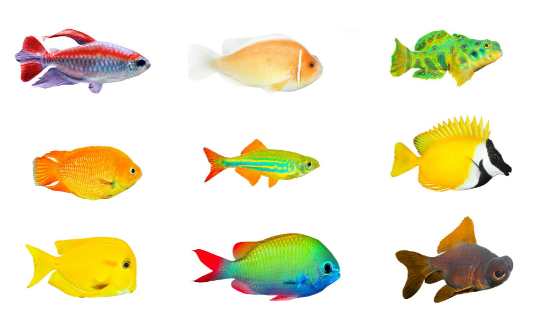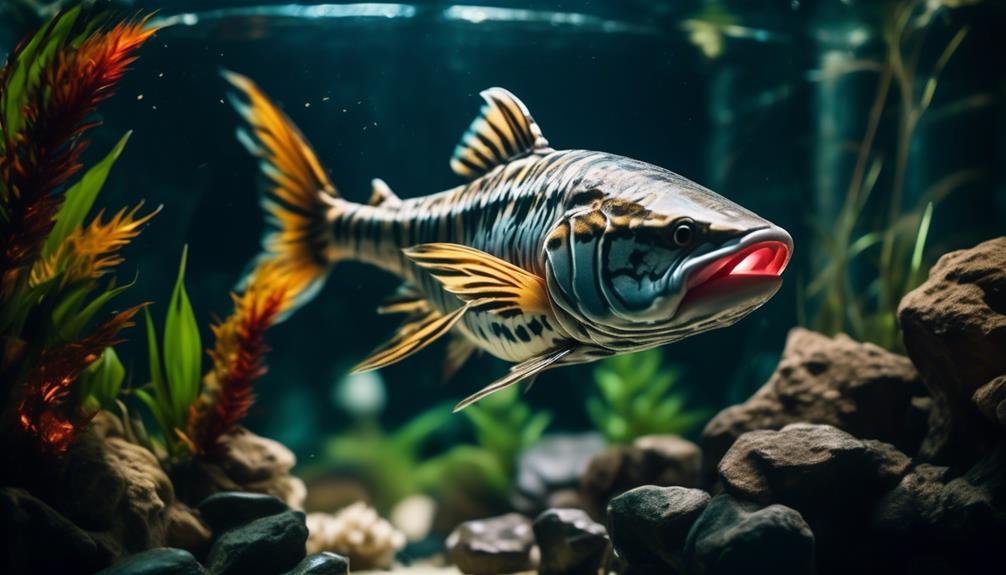
Are you ready to embark on a daring journey in the world of aquarium keeping? Look no further than the fierce and exotic tigerfish! These captivating creatures, hailing from various parts of Asia and New Guinea, are sure to add a touch of awe-inspiring beauty to your aquatic collection.
However, don’t be fooled by their striking appearance – caring for tigerfish is no walk in the park. These voracious predators require meticulous attention and specialized care. From providing a spacious, well-decorated habitat to catering to their specific dietary needs, the challenge of keeping tigerfish is not for the faint of heart.
But fear not, for if you’re willing to take on this exciting endeavor, this article will provide you with valuable insights and guidance on how to successfully care for these magnificent creatures.
So, are you ready to take the plunge into the captivating world of tigerfish?
Key Takeaways
- Tigerfish are native to Asia and New Guinea and thrive in freshwater and brackish habitats.
- They require a large tank of at least 100 gallons with warm water and a neutral pH.
- Tank decorations should include hardy vegetation, driftwood, and rockwork to mimic their natural habitat and provide security.
- Suitable tank mates for tigerfish include large cichlids, Bala sharks, and giant gouramis, but aggressive tank mates should be avoided.
Native Habitat and Physical Characteristics
Tigerfish, native to various parts of Asia and New Guinea, thrive in freshwater and brackish habitats. They display distinct physical characteristics that make them a captivating addition to any aquarium.
These large and impressive fish have a silver or gold base color with thick, dark bars running vertically along their body. Some tigerfish even exhibit reddish coloration along their back. Their name comes from these unique stripes that give them a fierce appearance.
With their size and striking coloration, tigerfish are sure to be a standout in your aquarium. Their presence adds a touch of exotic beauty to any aquatic environment.
Whether you’re an experienced aquarium owner or a beginner, having a tigerfish in your tank will surely be a rewarding and thrilling experience.
Aquarium Size and Water Requirements
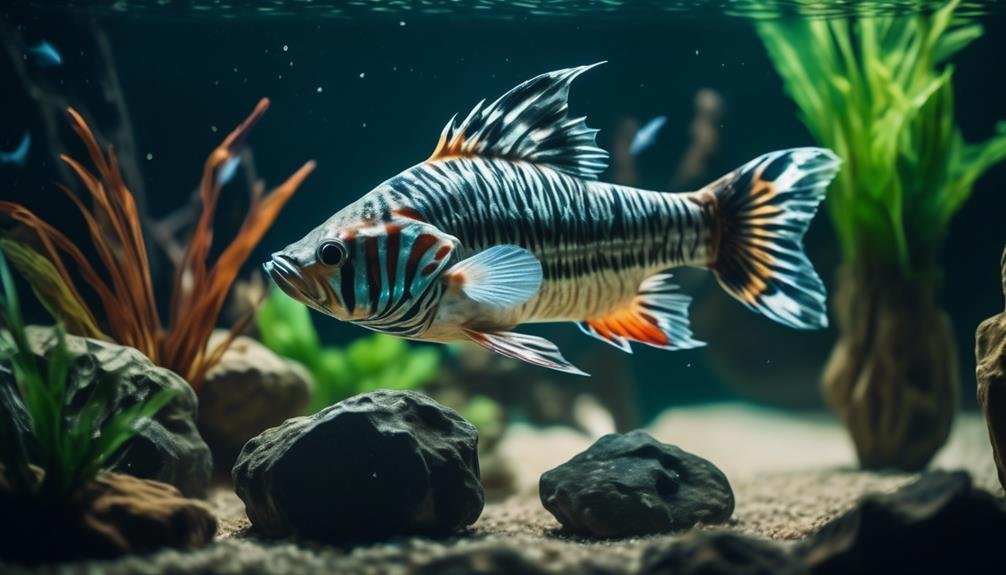
When setting up your aquarium for tigerfish, it’s crucial to consider the appropriate size and water requirements. Here are the key factors to keep in mind:
- Aquarium Size: Tigerfish require a large tank of at least 100 gallons or more. This allows them enough space to swim and ensures their comfort.
- Water Temperature and pH: Tigerfish prefer very warm water with a neutral pH. Maintaining a temperature range of 72F to 79F is ideal for their well-being.
- Tank Decoration: To provide hiding places, it’s recommended to decorate the tank with hardy vegetation, driftwood, and rockwork. This mimics their natural habitat and makes them feel secure.
Decorations and Tank Setup
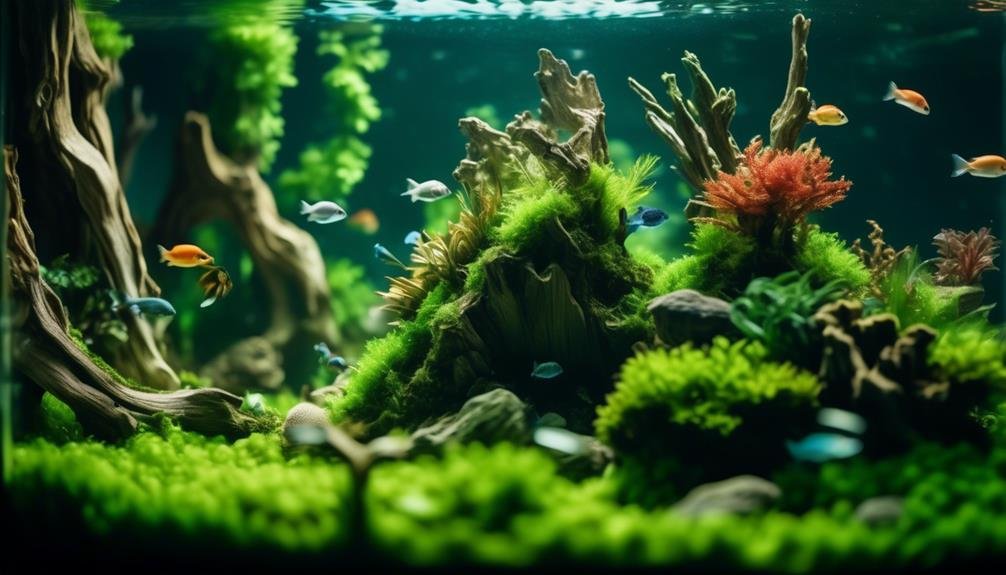
To create an optimal environment for your tigerfish, consider the decorations and setup of your aquarium.
Tigerfish prefer a tank with hardy vegetation, driftwood, and rockwork to provide hiding places. These decorations not only enhance the aesthetic appeal of the tank but also mimic the natural habitat of these fish.
The tank setup should also include plenty of open swimming space to accommodate the active nature of the tigerfish. It’s important to choose decorations that are sturdy and can’t be easily uprooted or knocked over by the tigerfish, as they can be quite strong and may rearrange their surroundings.
Compatible Tank Mates
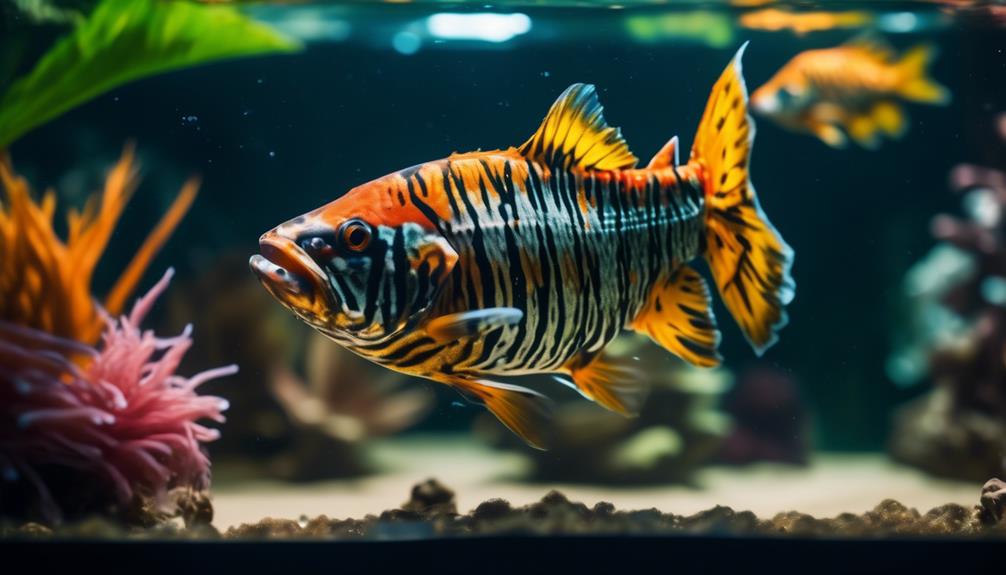
To ensure a harmonious aquarium environment, it’s important to carefully select compatible tank mates for your tigerfish. Here are some suitable options to consider:
- Large Cichlids: These fish are similar in size and temperament to tigerfish, making them good tank mates. Just ensure that the cichlids aren’t overly aggressive, as this can lead to conflicts.
- Bala Sharks: These silver-colored fish have a peaceful nature and can coexist with tigerfish. They also occupy different levels of the tank, which can help reduce competition for space.
- Giant Gouramis: These large, labyrinth fish can tolerate the aggressive behavior of tigerfish. They’ve a calm temperament and can add a unique element to your aquarium.
Feeding Habits and Diet

To ensure the health and well-being of your tigerfish, understanding their feeding habits and diet is essential for maintaining a thriving aquarium environment.
Tigerfish are carnivorous and primarily feed on other fish. It’s important to offer them commercial foods specifically designed for carnivorous fish.
Additionally, their diet can include a variety of fresh and frozen foods such as earthworms, small shrimp, small crabs, and small fish. Providing a diverse range of food options will help ensure they receive the necessary nutrients for growth and vitality.
Remember to feed them small portions multiple times a day to mimic their natural feeding habits. Monitoring their eating patterns and adjusting their diet accordingly will contribute to their overall health and happiness in the aquarium.
Care Difficulty and Maintenance

Maintaining Tigerfish in an aquarium requires regular maintenance and is best suited for experienced aquarium owners. To ensure the well-being of your Tigerfish, here are some important care tips to keep in mind:
- Water Quality: Tigerfish thrive in warm water with a neutral pH and low to moderate hardness. Regular water testing and maintenance are crucial to maintain optimal water conditions.
- Tank Size: Provide your Tigerfish with a spacious aquarium of at least 100 gallons or more. This will give them enough space to swim and explore.
- Diet: Being carnivorous, Tigerfish require a diet consisting of commercial foods designed for carnivorous fish, as well as a variety of fresh and frozen foods. Offer them earthworms, small shrimp, small crabs, and small fish to ensure a balanced diet.
Tips for Experienced Aquarium Owners
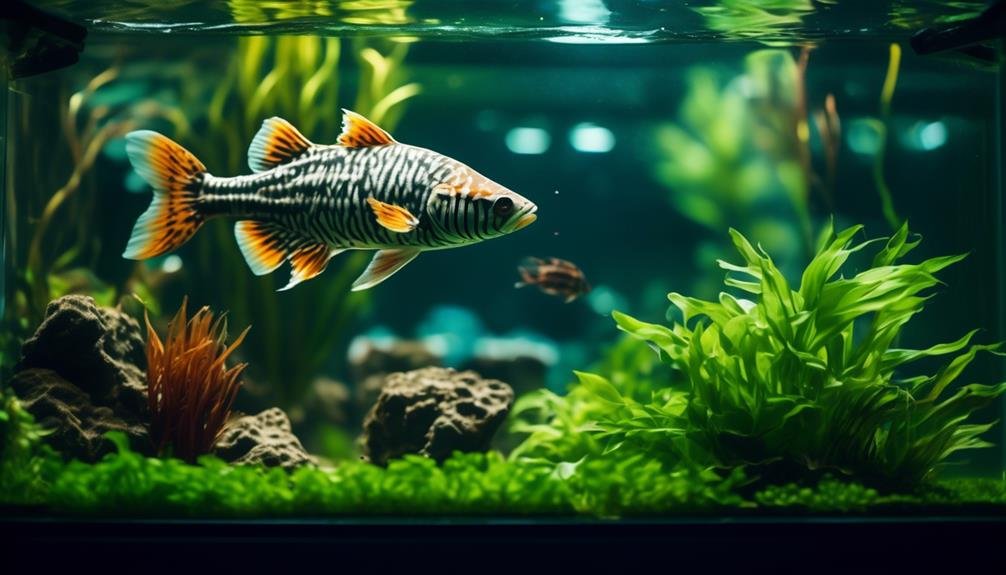
For experienced aquarium owners, here are some valuable tips to ensure the successful care of Tigerfish in your aquarium.
Tigerfish require a large aquarium of at least 100 gallons or more. They prefer very warm water with a neutral pH and low to moderate hardness, so maintaining the ideal temperature range of 72F to 79F is crucial.
Decorate the tank with hardy vegetation, driftwood, and rockwork to provide hiding places for the Tigerfish.
When it comes to tank mates, they can be kept with other fish of similar size, and sometimes even in groups with their own species.
Being carnivorous, they should be offered commercial foods designed for carnivorous fish, but their diet can also include fresh and frozen foods like earthworms, small shrimp, small crabs, and small fish.
Remember that taking care of Tigerfish requires weekly maintenance, so be prepared for the commitment.
Conclusion: The Thrilling Challenge of Keeping Tigerfish
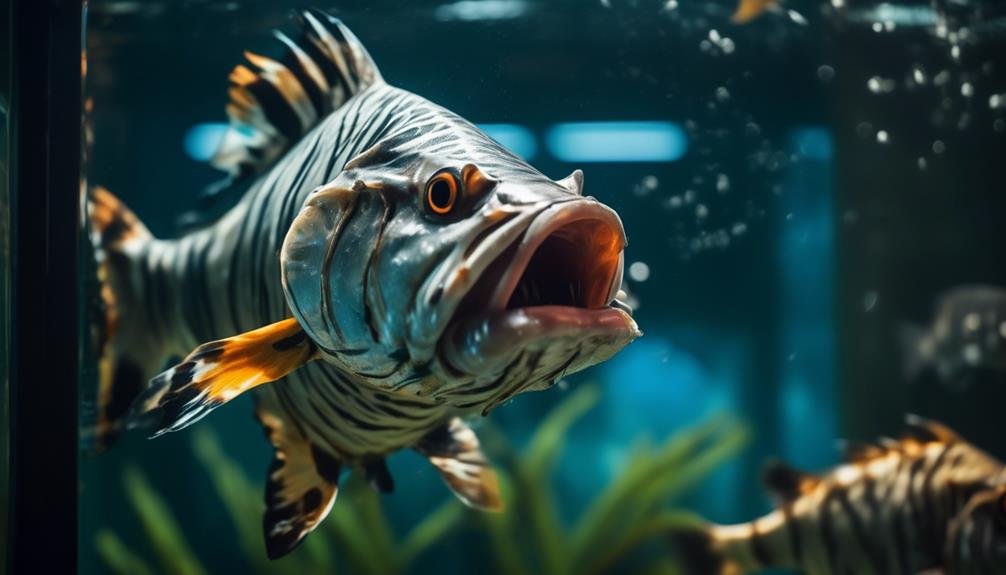
Keeping Tigerfish in your aquarium can be a thrilling and challenging endeavor. These fierce and exotic fish require specific care and attention to thrive in captivity. Here are three key points to remember:
- Adequate Space: Tigerfish need a large aquarium of at least 100 gallons or more to accommodate their size and swimming habits. Providing them with ample swimming space is crucial for their well-being.
- Specialized Environment: To replicate their natural habitat, maintain warm water temperatures between 72F to 79F and ensure a neutral pH with low to moderate hardness. Adding hardy vegetation, driftwood, and rockwork will create hiding places and mimic their natural surroundings.
- Carnivorous Diet: Tigerfish are carnivores and require a diet primarily consisting of other fish. Feed them commercial foods designed for carnivorous fish, along with a variety of fresh and frozen options like earthworms, small shrimp, crabs, and small fish.
With the right conditions and care, keeping Tigerfish can provide a thrilling and rewarding experience for aquarium owners.
Frequently Asked Questions
Are Tigerfish Aggressive Towards Other Fish in the Aquarium?
Yes, tigerfish can be aggressive towards other fish in the aquarium. It is important to choose tank mates of similar size and temperament to avoid any conflicts or harm to other fish.
Can Tigerfish Be Kept in a Community Tank With Smaller Fish?
Yes, tigerfish can be kept in a community tank with smaller fish of similar size. However, it is important to monitor their behavior and provide enough space and hiding places to prevent aggression.
What Is the Lifespan of a Tigerfish in Captivity?
The lifespan of a tigerfish in captivity can vary, but on average, they can live for around 10-15 years. Proper care, nutrition, and a suitable environment are crucial for their wellbeing and longevity.
Do Tigerfish Require a Specific Type of Filtration System in Their Aquarium?
Yes, tigerfish require a specific type of filtration system in their aquarium. They need a powerful filter that can handle their large size and high waste production. Regular cleaning and maintenance are essential.
Are There Any Specific Water Parameters That Tigerfish Need, Such as Specific Ph Levels or Water Hardness?
Yes, tigerfish require very warm water with a neutral pH and low to moderate hardness. The ideal temperature range for them is 72F to 79F. They have specific water parameter needs.
Are Trunkfish and Tigerfish Compatible in the Same Aquarium Environment?
While both exotic trunkfish as pets and tigerfish can thrive in a home aquarium, it’s generally not advisable to keep them together. Trunkfish are peaceful creatures that may be intimidated by the aggressive nature of tigerfish. It’s best to create separate environments to ensure the well-being of both species.
Conclusion
So, if you’re an experienced aquarium owner looking for a thrilling challenge, look no further than the fierce and exotic tigerfish!
With their striking appearance and specific care requirements, these carnivorous beauties are sure to make a bold statement in your aquarium.
Just make sure you have a large enough tank, maintain the right water conditions, and provide proper hiding places for them.
With dedication and experience, you’ll be rewarded with the satisfaction of successfully caring for these captivating creatures.




